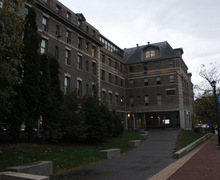Battle : Presbyterian waiting for chance to compete for Division I conference crown
Presbyterian College should be 5-4 in the Big South Conference. The Blue Hose have won five of nine games against conference teams, which would put them in a tie for third in the conference. But in league standings, the Blue Hose isn’t 5-4 – its 0-0.
Presbyterian cannot challenge for the league crown or the automatic bid to the NCAA Tournament for this upcoming season because it is in the second year of a five-year transition to the Division I level. The Blue Hose can play games against opponents in the Big South, but the games will not count for league standings.
The Blue Hose will not be able to compete for the league championship until 2011. But while they wait patiently for their crack at a bid to March Madness, they are making the most of what they have.
‘We’re 5-3 so far this year,’ Presbyterian head coach Gregg Nibert said. ‘That’s unbelievable for a transition team,’ Nibert said in a phone interview Friday.
Judging by the excitement in his voice, one would never know he has three and a half years of waiting left. But Nibert and the rest of his Blue Hose team have a plan, and it requires patience.
‘Oh it’s very hard for me and for the guys sitting on the bench,’ Nibert said. ‘But it’s a marathon, not a sprint. Our plan is for 2011-2012, and we want to have the best team we can when we become eligible. We will have five seniors then. You can’t put a price tag on that kind of experience.’
While the waiting period may be difficult, everyone involved knew what they were getting into. Nibert was upfront about his strategy with his recruits, letting them know that while they are going to have to sit out a year, the big payoff comes their fifth year, when they can win potentially the Big South.
But the most important part of the process boils down to one integral task: finding the right players.
Steven Gatkuoth and Aaron Gibbs are two of those players. After they both redshirted last year, they are back on the floor, playing right beside Al’Lonzo Coleman, Pierre Miller and Josh Johnson, three of the best players on the 2008-09 Presbyterian team.
But patience is a virtue. And while Presbyterian will not be eligible for the NCAA Tournament for another three seasons, the recruiting must continue.
One of the difficulties that teams like the Blue Hose run into is that they end up with a lot of juniors and seniors when they are eligible, but not many younger guys. This becomes a problem, because while the team might be competitive in their first year of eligibility, the subsequent years become disastrous.
The whole recruitment process, thus, becomes more difficult. Nibert’s plan calls for a gradual balancing out of the classes through heavy recruitment.
‘We’ll keep signing freshman to equal everything out,’ he said. ‘The goal is to be completely stable by 2015-2016.’
In 2004 when the ruling was made to change the transition of waiting from 13 years to five, the wheels began to turn inside the mind of Tim Miles, the head basketball coach at North Dakota State University at the time.
Competing as a team independent from any conference, the Bison decided to redshirt 10 of 11 players.
‘We were just buying time, then,’ Miles said. ‘We just had nothing to offer. However, he did get them all to buy into (the idea of redshirting).’
Miles, one of the first coaches to use redshirting as a recruiting tool, said he was inspired by Jerry Krause, the director of basketball operations at Gonzaga University. Miles credits Krause’s ability to build up the program at Gonzaga by redshirting players and building up talent and experience.
But it was still Miles who integrated redshirting into the process of teams moving up to DI.
While NDSU was without a league and ineligible for the NCAA Tournament, Miles recalls setting smaller goals, like winning individual tournaments.
‘I always felt bad for the juniors and seniors that spent time on the bench – I felt like I was letting them down,’ Miles said. ‘But they were willing to make the sacrifice. They were a huge part of the process too.’
Miles, now the head coach at Colorado State University, looks back on the process of moving a team into Division I and feels a great sense of accomplishment.
‘We wanted to put North Dakota State on the map, and look at them now,’ Miles said. ‘I mean, I wouldn’t have ever dreamed that a guy in Syracuse would have any interest in North Dakota State.
‘On the wall of the gym (at North Dakota), there is a huge painting of two bison knockin’ into each other’s heads. It’s this silly lookin’ ’70s/’80s painting, but on the wall it also says ‘Bring on the Competition.’ We accomplished something there, and that painting always represented that extra ‘something’ to us.’
Published on January 26, 2009 at 12:00 pm





